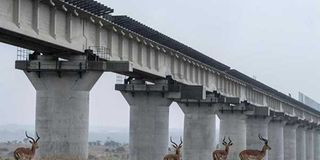SGR project brings to question our wildlife conservation ethos

Impalas walk near the elevated railway line in Nairobi National Park. PHOTO | FILE | YASUYOSHI CHIBA | AFP
What you need to know:
- The old Nairobi and Mombasa terminuses are of great historical value and would have better attracted many tourists to the new train.
- The wires are features that were not there before and are disrupting natural flow of wild animals across the savannah.
- I fail to see the logic of having barbed wire around the latest tracks or inside animal reserves.
- Conservation needs to form part of our DNA as we are the natural custodians of this unique heritage of wildlife
The standard gauge railway (SGR) project now appears like a toy car I recently bought for my nephew in a local supermarket.
It was Chinese-made, remote-controlled and looked like a lovely cruiser. But when we took it home and tried it out, it only lit up, crackled a little but did not move an inch.
My nephew’s disappointment was a sight to behold. No amount of new batteries and engineering expertise could get the toy car moving.
It just sits there now, cluttering the place, until we find something more durable to appease the little boy.
EXCITEMENT
Like my nephew’s toy, the SGR initiation was followed by excitement, pomp and colour and, to many Kenyans, it appears not to have lived up to expectations. The bullet train was not what arrived; we got just a bog-standard train that was newer and shinier than the one before it.
The commute to and from the railway station turns out to be like by the good old matatu — only that it has been given a posher name of ‘shuttle’. The location of Nairobi Terminus for me was a little confusing to start with; it turned out that it was, in fact, in Syokimau, Machakos County, and not in the city county!
Having not kept abreast with the new Nairobi Terminus while out of the country, I remember recently arriving at the now-old Nairobi Railway Station maiden SRG train ride. It took a kind security guard, and not notices or signposting, for me to know Nairobi Terminus had ‘moved’.
I had about an hour to get through the heavy city traffic in a taxi to catch my afternoon train to Mombasa, which I still missed!
NEW STATIONS
SGR, however, has life in it. It is easier to keep it and make it work somehow — unlike my nephew’s ‘car’, which will certainly end up in the trash.
The great thing about SGR is that it is quite economical for a light traveller who can easily catch a matatu to and from the new stations. But if you have large suitcases and depending on taxis like I did, it ends up being quite expensive. A one-way journey ended up costing me Sh5,000, including the ticket. The little things — such as location, information on all connections and extra costs that were not initially factored in — have become inconveniencing to some passengers.
SCENIC ROUTE
The old Nairobi and Mombasa terminuses are of great historical value and would have better attracted many tourists to the new train. Again, the Nairobi-Mombasa railway line cuts through one of the most amazing and scenic routes in the world, with its concentration of wildlife. A spectacle to enjoy, even on ‘Madaraka Express’.
However, what I found of concern are the barbed wire built along both sides of the track, in some places, double-wired. That restricts movement of animals to one side of the track. Clearly, freedom of movement of animals was overlooked.
The wires are features that were not there before and are disrupting natural flow of wild animals across the savannah. A recent report on the BBC wildlife series showed that animals such as elephants are, in fact, getting caught in the barbed wires they never envisaged along their routes.
I fail to see the logic of having barbed wire around the latest tracks or inside animal reserves.
CACTUS HEDGES
The traditional eco-friendly cactus hedges would have sufficed. The savannah is one of the rarest animal habitats in the world and fencing off the rail tracks with barbed wires to inhibit animal’s natural flow has the potential of decimating them and completely changing the character of this unique land.
The environmental challenges posed by SGR, particularly on wildlife, is well documented. The disregard for the concern on wildlife along the SGR line shows our lack of appreciation of our wildlife heritage.
No doubt, conservation of wildlife has become a ‘white’ people affair and explains mushrooming of conservation units in private firms and ranches.
The natural conservation of wildlife needs to be in the natural habitat in which they are found. We have set up many such parks and reserves for wildlife and efforts must be made to preserve their uniqueness, even as we embrace development projects such as the SGR.
WILD ANIMALS
Wildlife deserve to be part of the environment. We found them here, after all. The human-wildlife conflict we keep hearing about can be partly resolved by educating the local communities on how best to coexist with wild animals. To bring up future generations that can appreciate this unique heritage, conservation must be made part of our curriculum.
Most importantly, growth of human settlements must be planned away from the wildlife reserves and migration routes. We can’t colonise natural wildlife habitats and then cry of being mauled.
Conservation needs to form part of our DNA as we are the natural custodians of this unique heritage of wildlife — just as it was centuries ago.
Ms Guyo is a legal researcher. [email protected] @kdiguyo





